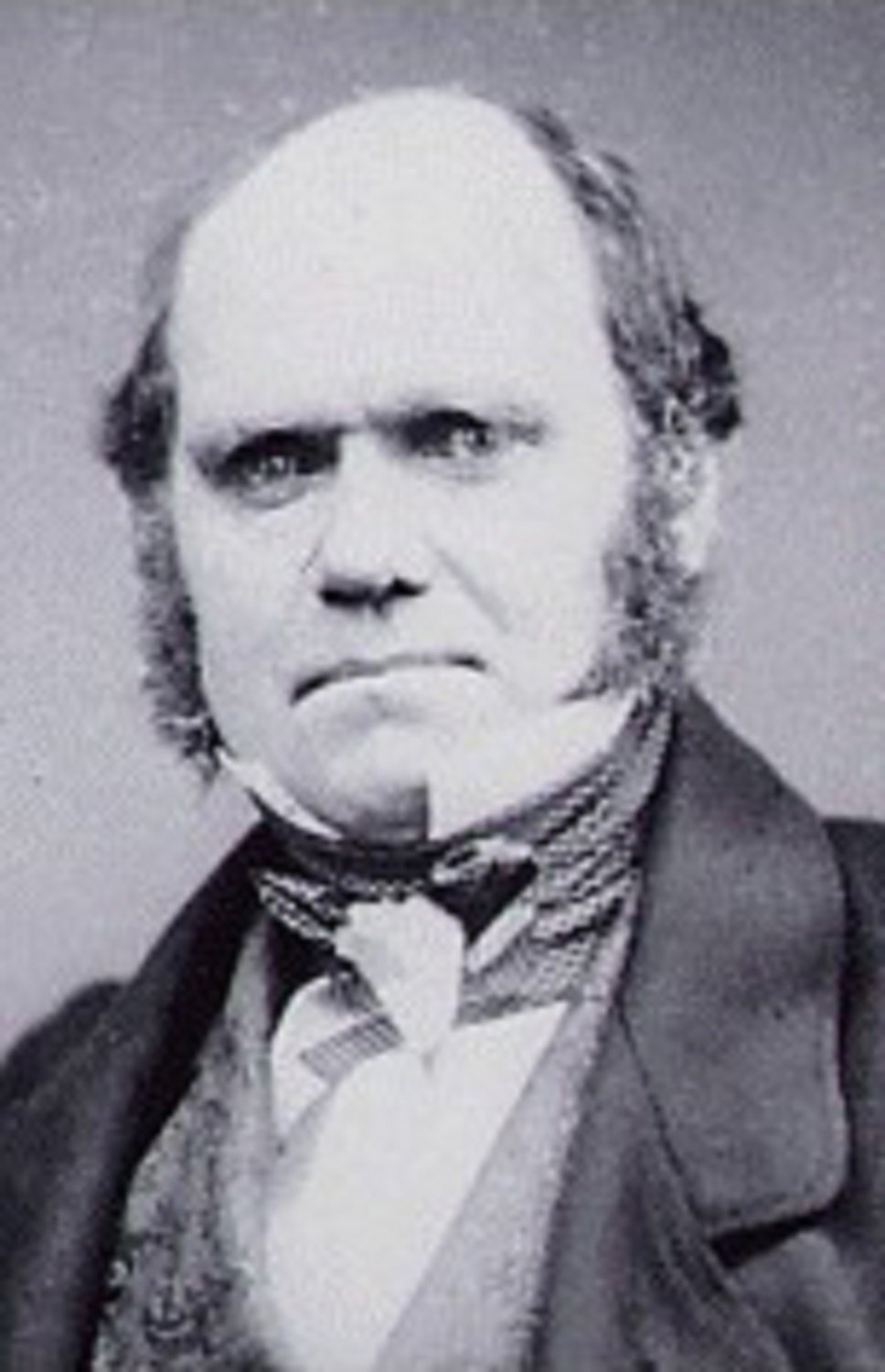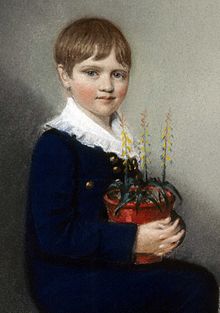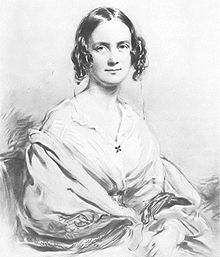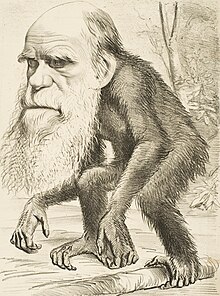Charles Darwin: Difference between revisions
Psychonaut (talk | contribs) m Reverted edits by User:Vfp15 to last version by User:Curps |
|||
| Line 20: | Line 20: | ||
Darwin was surveying strata in Wales on his own when he received a message that his intended companion had died, dashing his plans to visit Madeira, but on his return home he received another letter. Henslow had recommended Darwin for the position of gentleman's companion to [[Robert FitzRoy]], the captain of [[HMS Beagle|HMS ''Beagle'']] which was departing in December on a two-year expedition to chart the coastline of [[South America]] and would give him opportunities as a naturalist. His father objected to the voyage, thinking it a waste of his son's time, but was eventually persuaded by Josiah Wedgwood to agree to Charles going and to pay for his son's expedition which eventually stretched to five years. |
Darwin was surveying strata in Wales on his own when he received a message that his intended companion had died, dashing his plans to visit Madeira, but on his return home he received another letter. Henslow had recommended Darwin for the position of gentleman's companion to [[Robert FitzRoy]], the captain of [[HMS Beagle|HMS ''Beagle'']] which was departing in December on a two-year expedition to chart the coastline of [[South America]] and would give him opportunities as a naturalist. His father objected to the voyage, thinking it a waste of his son's time, but was eventually persuaded by Josiah Wedgwood to agree to Charles going and to pay for his son's expedition which eventually stretched to five years. |
||
Charles Darwin later mused that his voyage on the ''Beagle'', the single most important event of his life, had only been possible because his uncle happened to be free to drive 30 miles to meet Captain Fitz-Roy. |
|||
== Journey on the Beagle == |
== Journey on the Beagle == |
||
| Line 148: | Line 150: | ||
*[http://charles-darwin.classic-literature.co.uk/insectivorous-plants/ Insectivorous Plants] |
*[http://charles-darwin.classic-literature.co.uk/insectivorous-plants/ Insectivorous Plants] |
||
*[http://charles-darwin.classic-literature.co.uk/observations-geologiques-sur-les-iles-volcaniques/ Observations Geologiques sur les Iles Volcaniques (French)] |
*[http://charles-darwin.classic-literature.co.uk/observations-geologiques-sur-les-iles-volcaniques/ Observations Geologiques sur les Iles Volcaniques (French)] |
||
==Trivia== |
|||
* Charles Darwin and [[Abraham Lincoln]] were both born on [[February 12]], [[1809]]. |
|||
==See also== |
==See also== |
||
Revision as of 10:25, 21 January 2005

Charles Robert Darwin (February 12, 1809 – April 19, 1882) was an English naturalist whose revolutionary theory laid the foundation for both the modern theory of evolution and the principle of common descent by proposing natural selection as a mechanism. He published this proposal in 1859 in the book The Origin of Species, which remains his most famous work. A worldwide sea voyage aboard HMS Beagle and observations on the Galapagos Islands in particular provided inspiration and much of the data on which he based his theory.
Early life

Charles Darwin was born in Shrewsbury, Shropshire, England, on February 12, 1809 at the family home, The Mount House. He was the fifth of six children of Robert and Susannah Darwin (née Wedgwood), and the grandson of Erasmus Darwin, and of Josiah Wedgwood, a family of the Unitarian church. See also Darwin–Wedgwood family.
His mother died when he was only eight and the next year he became a boarder at the Shrewsbury School. After finishing school, Darwin went to Edinburgh University in 1825 to study medicine.
At Edinburgh his disgust at the anatomy lectures of professor Alexander Munro III and his revulsion at the brutality of surgery at the time led him to neglect his medical studies, but in his second year he became active in student societies for naturalists. In the Plinian society he became an avid student of Robert Edmund Grant, learning from Grant's enthusiasm for the theories of Lamarck and Charles' grandfather Erasmus about evolution by acquired characteristics. He joined Grant in pioneering investigations of the life cycle of marine animals on the shores of the Firth of Forth where Grant found evidence for homology, the radical theory that all animals had similar organs differing only in complexity. In March 1827 Darwin made a presentation to the Plinian society of his discovery that black spores often found in oyster shells were the eggs of a skate leech. Darwin also sat Robert Jameson's natural history course, learning about stratigraphic geology and getting to assist with the collections of the Museum of Edinburgh University, then one of the largest in Europe. At professor Robert Jameson's Wernerian Natural History Association Charles saw John James Audubon give a demonstration of his method of using wires to prop up birds to draw or paint them in natural positions.
His father, unhappy that his younger son would not become a physician and fearing that Charles would become a "ne'er do well", enrolled him at Christ's College, Cambridge in 1827 on a BA course to qualify as a clergyman. This was a sensible career move at a time when a "living" as an Anglican parson provided a comfortable income and when most naturalists in England were clergymen who saw it as part of their duties to explore the wonders of God's creation.
At Cambridge Charles preferred riding and shooting to studying, and along with his cousin William Darwin Fox became engrossed in the current craze for the (competitive) collecting of beetles. Fox introduced him for advice on this to the Revd. John Stevens Henslow, professor of botany, and Charles subsequently joined his natural history course. Henslow's outings were attended by 78 men including the Revd. William Whewell and Charles became the 'favourite pupil', known as "the man who walks with Henslow". When exams loomed Charles focused on his studies, becoming particularly enthused by the set texts by Paley which included the argument of divine design in nature. He got private tuition from Henslow whose subjects were maths and theology, and in his finals in January 1831 he shone in theology and scraped through in classics, maths and physics, coming 10th out of a pass list of 178.
Although he had gained his degree, residence requirements kept Darwin at Cambridge till June and following Henslow's example and advice he was in no rush to take holy orders. Inspired by Alexander von Humboldt's Personal Narrative he wanted to study natural history in the tropics and planned to visit Madeira with some class-mates upon graduation. Knowing the need for geological skills, Henslow introduced Charles to the great geologist the Revd. Adam Sedgwick and Darwin joined his course, then that summer worked with him at mapping strata in Wales.
Darwin was surveying strata in Wales on his own when he received a message that his intended companion had died, dashing his plans to visit Madeira, but on his return home he received another letter. Henslow had recommended Darwin for the position of gentleman's companion to Robert FitzRoy, the captain of HMS Beagle which was departing in December on a two-year expedition to chart the coastline of South America and would give him opportunities as a naturalist. His father objected to the voyage, thinking it a waste of his son's time, but was eventually persuaded by Josiah Wedgwood to agree to Charles going and to pay for his son's expedition which eventually stretched to five years.
Charles Darwin later mused that his voyage on the Beagle, the single most important event of his life, had only been possible because his uncle happened to be free to drive 30 miles to meet Captain Fitz-Roy.
Journey on the Beagle
See also The Voyage of the Beagle
Darwin's work during the Beagle expedition allowed him to study both the geological properties of continents and isles and a multitude of living organisms and fossils. He collected an enormous number of specimens new to science in a very methodical way, and his specimens sent back to the University of Cambridge were by themselves a significant contribution to science, and made him one of the precursors of ecology. No other collector has rivalled his work since. He also took many detailed notes on everything he observed, which would form the basis for his later work. Others on board, including FitzRoy, also made significant collections which were deposited in the British Museum by the Admiralty.
Before they left England FitzRoy had given Darwin a copy of the first volume of Charles Lyell's Principles of Geology which explained features as the outcome of a gradual process over huge periods of time, and Darwin wrote home that he was 'seeing' land-forms as if he had the eyes of Lyell. During his voyage, he visited the Cape Verde Archipelago, the Falkland Islands, the South American coast, the Galapagos Islands, New Zealand and Australia, meeting native peoples, seeing natural wonders, and above all, collecting considerable quantities of specimens which were sent back at intervals during the voyage. Quite apart from the wealth of detailed biological accounts they give, Darwin's published accounts also provide us with social, political, and anthropological insights into the areas he visited. For instance his account of how the Gaucho of Argentina lived is particularly interesting. Further, the journals reveal him to be a very active and intrepid adventurer who thought nothing of embarking on 200 mile journeys across dangerous territories, in marked contrast to the better known image of an elderly country gentleman.
While in South America, he contracted Chagas' disease from insect bites. Although not fatal, it recurred several times during his life, and prevented him from being particularly active.
On the Beagle's return on October 2, 1836, Darwin was invited by FitzRoy to contribute the natural history section to the captain's account of the Beagle's voyage, and used his field notes as the basis of the third volume of this account, published in 1839. Darwin's Journal and Remarks was very popular and later that year was published on its own becoming the best-seller nowadays known as "The Voyage of the Beagle", establishing Darwin as an author.
Darwin shapes his theory
After returning from the voyage, Darwin analysed the specimens he collected, and considered similarities between fossils and living species within the same geographic area. In particular, every island in the Galapagos Archipelago had its own kind of tortoises and birds that were all slightly different in appearance, favoured food etc., but otherwise similar.
In the spring of 1837 ornithologists at the British Museum informed Darwin that the several very different species of birds he had taken in the Galapagos were all finches, and from FitzRoy's collection he was able to relate the finches to separate islands. This, coupled with a re-reading of Thomas Malthus' 1798 essay on populations, triggered a chain of thought that would culminate in the theory of evolution by natural and sexual selection. He developed the hypothesis that, for example, all the different turtles had originated from a single turtle species, and had adapted to life on the different islands in different ways.
Based on these thoughts, he formulated his ideas about the changes and developments of species in his Notebook on the Transmutation of Species, which was in accordance with Lyell's Principles of Geology involving gradual change over a long time, and Thomas Malthus' Essay on the Principle of Population which stated that the size of a population is limited by the food resources available. Realizing the potential of this understanding, Darwin undertook extensive experiments with pigeons and plants, and extensive consultation with pig breeders and other animal husbanders, in an attempt to discover holes in the hypothesis. He took his time with careful research until he had enough evidence, knowing that a great deal of opposition would likely erupt when he presented his theory.
First writings
Following his account of The Voyage of the Beagle, Darwin's Zoology of the Voyage of H.M.S. Beagle was published between 1839 and 1843 in five volumes. Darwin published scientific treatises, including an explanation for the life-cycle of coral atolls in the South Pacific published in 1842.
In 1842, Darwin formulated a short "Pencil Sketch" of his theory and by 1844 had written a 240 page "Essay" which provides an expanded version of his early ideas on natural selection. Between 1844 and 1858, when he would present his theory to the Linnean Society of London, Darwin wrote his masterpiece, modifying his theory in a number of ways as he wrote.
Marriage and children

Darwin married his cousin Emma Wedgwood in 1839. After living for a number of years in London, the couple eventually moved to Down House, in Downe, Kent (which is now open to public visits, south of Orpington). The Darwins had ten children, three of whom died early. Many of these and their grandchildren would later achieve notability themselves (see Darwin–Wedgwood family)
- William Erasmus Darwin (27 December 1839 – 1914)
- Anne Elizabeth Darwin (2 March 1841 – 22 April 1851)
- Mary Eleanor Darwin (23 September 1842 – 16 October 1842)
- Henrietta Emma "Etty" Darwin (25 September 1843 – 1929)
- George Howard Darwin (9 July 1845 – 7 December 1912)
- Elizabeth "Bessy" Darwin (8 July 1847 – 1926)
- Francis Darwin (16 August 1848 – 19 September 1925)
- Leonard Darwin (15 January 1850 – 26 March 1943)
- Horace Darwin (13 May 1851 – 29 September 1928)
- Charles Waring Darwin (6 December 1856 – 28 June 1858)
The Origin of Species
See also The Origin of Species.
Announcement of theory
Darwin's work brought him a correspondence relationship with Alfred Russel Wallace, working in the islands of the South Pacific and Indonesia. Wallace had been one of Darwin's numerous providers of natural history specimens, and was considerably lower in social status than Darwin himself. On June 18th 1858, Wallace sought Darwin's ideas on a theory Wallace had developed which almost exactly mirrored Darwin's own work. Darwin was himself horrified at the prospects of being scooped, but also felt bound to respect Wallace's claim to priority. Seeking advice from his scientific friends, he was encouraged to announce his theory along with Wallace's contribution, and to establish that he had in fact started developing the theory ten years before Wallace did. On July 1, 1858, Darwin's announcement of his theory was read to the Linnean Society, in London, jointly with Wallace's paper. Neither men were present at the reading, Darwin was at home with his dying son, and Wallace was in the Far East somewhere. The paper was entitled On the Tendency of Species to form Varieties; and on the Perpetuation of Varieties and Species by Natural Means of Selection. Fortunately for Darwin, Wallace was satisfied with the arrangement: though he would always be second-string to Darwin (his role reduced to that of catalyst), to be linked to a well-respected naturalist of high social standing like Darwin was still a fantastic career opportunity, perhaps more than he could have accomplished himself in the tight-knit circle of Victorian-era science.
The initial announcement of the theory garnished little immediate attention. It was mentioned briefly in a few small reviews but did not yet command much further thought, and was not yet fully distinguishable to most people from other varieties of evolutionary thought. For the next thirteen months, Darwin would labour to produce what was originally to be an abstract of his "big book on species". Receiving constant promotion and encouragement from his scientific friends, Darwin finally finished On the Origin of Species by Means of Natural Selection and arranged to have it published. Through his network of social connections and correspondents, Darwin's book was given a great deal of initial attention, marketed by his scientifically respectable friends as being a worthy contribution to scientific thought, and with reviews placed in prominent periodicals. As attention and controversy gathered, the book was translated into numerous languages and went through a number of reprints, becoming a staple scientific text accessible to a newly curious middle class. It would prove to be the most controversial and discussed scientific book ever written.
Reaction

It provoked an outraged response from the Church of England. At a meeting of the British Association for the Advancement of Science in Oxford, 'Soapy Sam' Wilberforce, the Bishop of Oxford, and Robert FitzRoy (the Captain of HMS Beagle) argued against Darwin, and Thomas Huxley established himself as "Darwin's bulldog" – the fiercest defender of evolutionary theory on the Victorian stage. On being asked by Wilberforce, whether he was descended from monkeys on his grandfather's side or his grandmother's side, Huxley, recognizing his opportunity, apparently muttered to himself: "The Lord has delivered him into my hands", and then replied that he "would rather be descended from an ape than from a cultivated man who used his gifts of culture and eloquence in the service of prejudice and falsehood" (several alternative versions of this supposed quote exist, see Wilberforce and Huxley: A Legendary Encounter). The story spread around the country: Huxley had said he would rather be an ape than a Bishop.
Darwin himself did not personally defend his theories in public, though he watched the ongoing debates eagerly. He was constantly in ill health, and preferred to garnish support by means of his letters and correspondence. A core circle of scientific friends–Huxley, Charles Lyell, Joseph Dalton Hooker, and Asa Gray–actively pushed his work onto the fore of the scientific and public stage, and defended him against his many mounting critics. Unexpectedly to Darwin, his theory became not only a key scientific controversy of the era, but was also resonated with many anti-Victorian sentiments at the time, becoming a key fixture of popular culture of the period (and beyond).
Later works and death
In several of his later books The Variation of Animals and Plants Under Domestication (1868), The Descent of Man and Selection in Relation to Sex (1871) and The Expression of Emotions in Animals and Man (1872), Darwin expanded on many topics introduced in Origin of Species. The Descent of Man, in particular, aroused even greater argument since it theorized that humanity was descended from apes. Forever afterward, Darwin would be characterized as "the monkey man", and cartoons often depicted him as part ape.
Darwin's life work provoked continuing discussions in the scientific community, and established more than anything else that "evolution" itself had occurred: not necessarily that it was by natural or sexual selection (this particular recognition would not become fully standard until the rediscovery of Gregor Mendel's work in the early 20th century). He became a member of the Royal Society of London in 1839 (on the basis of his collecting during his voyages) and of the French Academy of Sciences (l'Académie des Sciences) in 1878.

Darwin died in Downe, Kent, England, on 19 April 1882 and was given a state funeral. William Spottiswoode, President of the Royal Society arranged for Darwin to be buried in Westminster Abbey near Isaac Newton, despite Darwin's wishes that he be buried in Downe.
Views on religion
Charles Darwin came from a Non-conformist background, then studied Anglican theology with the aim of becoming a clergyman, at a time of religious and political turmoil in England. Though he recalled that "Whilst on board the Beagle I was quite orthodox" he later struggled with faith and became increasingly agnostic.
A popular Christian urban legend falsely claims (variously) that he "converted" to Christianity on his deathbed. [1], [2], [3]
See Charles Darwin's views on religion.
Legacy
Charles Darwin's theory of evolution based upon natural selection changed the thinking of countless fields of study from biology to anthropology. His work was extremely controversial by the time he published it and many during his time didn't take it seriously. Darwin's theory of evolution was a significant blow to creationism and notions of intelligent design prevalent among 19th century Europe.
As a humorous celebration of the theory of evolution, the annual Darwin Award is bestowed on individuals who "aid the process of evolution by demonstrating their unfitness" through fatally stupid actions.
In Australia's Northern Territory, the capital city (originally Palmerston) was renamed Darwin to commemorate the author's 1839 visit there, and the territory now also boasts Charles Darwin University and Charles Darwin National Park.
Darwin was given particular recognition in 2000 when his image appeared on the Bank of England ten pound note, replacing Charles Dickens. His impressive and supposedly hard-to-forge beard was reportedly a contributing factor in this choice. Darwin's Portrait on the £10 Note
Darwin is included in the top 10 of the 100 Greatest Britons poll sponsored by the BBC and voted for by the public.
Social Darwinism
A version of natural selection was also applied to human society (politics, economics, etc.). The most famous of these doctrines is Social Darwinism, a term that first appeared about 1900, where the rule of the strong is justified by claims that it merely reproduces in society Nature's rule that the fittest survive. It is clear that Darwin never advocated this extension of Herbert Spencer's philosophy. He reacted strongly against the slavery he saw in South America, causing a dramatic though brief dispute with FitzRoy who thought slavery justifiable, and while Darwin contrasted the miserable condition of savages with civilised society, he was clear that the difference was due to learning and culture rather than being innate. He evinced great sympathy for enslaved or oppressed people and looked forward to a day when his 19th century concept of knowledge and enlightenment would bring civilization to all men.
References
- Voyage of the Beagle, Charles Darwin (including Robert FitzRoy's Remarks with reference to the Deluge), Penguin Books, London 1989 ISBN 0-14-043268-X
- Darwin, Adrian Desmond and James Moore, Michael Joseph, the Penguin Group, London 1991 ISBN 0-7181-3430-3
- Charles Darwin: The Life of a Revolutionary Thinker, Dorothy Hinshaw Patent, Holiday.
- The Darwin Deathbed Conversion Question
Works of Charles Darwin
- The Moral State of Tahiti
- 1839 – The Voyage of the Beagle
- 1858 – On the Perpetuation of Varieties and Species by Natural Means of Selection
- 1859 – On the Origin of Species by Means of Natural Selection, or the Preservation of Favoured Races in the Struggle for Life
- 1871 – The Descent of Man and Selection in Relation to Sex
- Expression of Emotions in Man and Animals
- Life and Letters of Charles Darwin, Volume I
- Life and Letters of Charles Darwin, Volume II
- More Letters of Charles Darwin Volume I
- More Letters of Charles Darwin Volume II
- Formation of vegetable Mould Through the Action of Worms
- Geological Observations of South America
- Geological Observations of Volcanic Islands
- Movement and Habits of Climbing Plants
- Structure and Distribution of Coral Reefs
- Variation of Plants and Animals Under Domestication (PDF Format)
- Autobiography of Charles Darwin
- The Variation of Animals and Plants Under Domestication V1
- The Variation of Animals and Plants Under Domestication V2
- The Different Forms of Flowers on Plants of the Same Species
- The Effects of Cross and Self-Fertilisation in the Vegetable Kingdom
- The Power of Movement in Plants
- Insectivorous Plants
- Observations Geologiques sur les Iles Volcaniques (French)
See also
- Lamarck
- Patrick Matthew
- Charles Darwin University (Australia)
- Darwin College, Cambridge
- The Voyage of the Beagle
External links
- Galapagos, Charles Darwin Adventure
- Darwin Literature, Chapter-indexed, searchable versions of Darwin's works.
- Note: The comprehensive and authoritative web source for Darwin texts (essentially all of them, in a consistent and citable format) is here: http://pages.britishlibrary.net/charles.darwin/
- See also: http://textbook.wikipedia.org/wiki/Charles_Darwin
- Charles Darwin's Books in an easy to read format.
- AboutDarwin.com
- The Friends of Charles Darwin
- Darwin's Portrait on the £10 Note
- 12 different portraits of Charles Darwin at the National Portrait Gallery, UK
